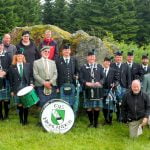Among Caulfeild's principal routes are the long road north from Loch Lomond to Fort William across Rannoch Moor including the Devil’s Staircase; The Rest and Be Thankful from Loch Lomond to Inveraray; and the road from Blairgowrie to Inverness through the Eastern Highlands via Braemar and the Lecht Pass, parts of which can still be seen and on which this bridge is built.
A warrant to provide Caulfeild with gunpowder to make this road was issued in 1748. The following year, 300 men from the Welsh Fusiliers were sent to start work on the road from Blairgowrie and another 300 from General Guise's regiment were ordered to work southward from Braemar, the intention being that both parties should meet at the Spittal of Glenshee. However at the seasons end, General Guise's detachment had stopped about two and a half miles to the north of the Spittal and the Blairgowrie party had only reached Dalrulzion. It was not until 1750 that the six remaining miles were completed.
The bridges built during what some have described as the largest civil engineering project in Scotland since Roman times are impressive, and the one here at the Spittal of Glenshee is no exception. With its 12 foot wide humpback outline, it is thought to have been constructed between 1749 and 1763.
This massive military road building project, begun by Wade and continued by Caulfeild, completely overhauled the British government's military infrastructure in Scotland and even led to a sixth verse of the British National Anthem being written, said to have been first performed in London in 1745. The words are:
Lord grant that Marshal Wade
May by thy mighty aid
Victory bring.
May he sedition hush,
And like a torrent rush,
Rebellious Scots to crush.
God save the King!
In 1803, with these roads no longer needed for military purposes (the Jacobite threat having been crushed at Culloden in 1746), and in a state of terrible repair, they passed into the control of the Commission of Highland Roads and Bridges. A new survey was sent north to look at the state of affairs, and to assess what use the roads and the network would serve going forward and whom.
It was drovers, merchants, travellers and the like that now travelled where soldiers once marched; and the roads needed to be upgraded and improved to meet new social and economic requirements. Thomas Telford, the great Scottish engineer was responsible for upgrading, straightening, widening and generally improving the efficiency of the network.
The modern road network of the Highlands evolved from these improvements but the essential plan of the system is still fundamentally based upon the military roads built by Wade and Caulfeild over 250 years ago.
Sources: General Wade's Legacy by Lindsay Farquharson


